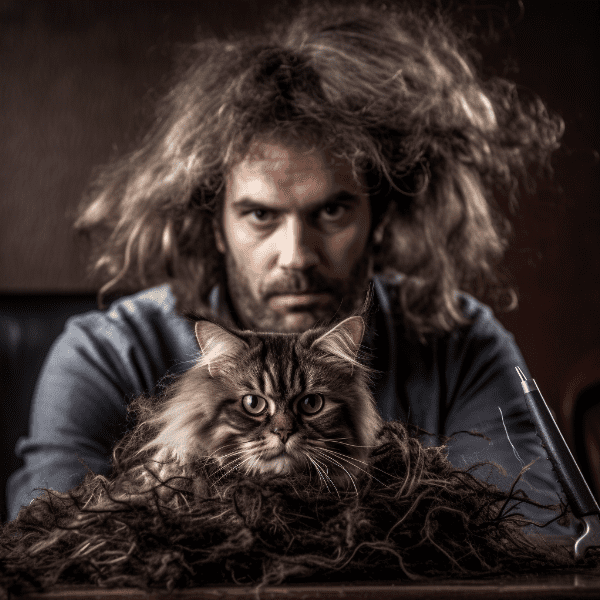Table of Contents
- Why You Might Need to Shower Your Cat
- Preparing Your Cat for a Shower
- Choosing the Right Shampoo and Supplies
- Getting Your Cat into the Shower
- Washing Your Cat Safely and Effectively
- Rinsing and Drying Your Cat
- Dealing with Common Challenges
- Alternatives to Full Showers for Cats
- Maintaining Your Cat’s Cleanliness and Health
- When to Seek Professional Help for Cat Grooming
Why You Might Need to Shower Your Cat
Cats are known for being fastidious groomers, and in most cases, they can take care of their cleanliness on their own. However, there are several situations where giving your feline friend a bath becomes necessary.
Health Issues
If your cat is suffering from certain skin conditions or infections, your vet may recommend bathing them to help alleviate symptoms and promote healing. Additionally, if your cat has an infestation of fleas, ticks, or other parasites, a bath can help to remove them.
Environmental Factors
Sometimes, your cat may get into something that is difficult to clean off with their own grooming techniques. For example, if your cat has gotten into a sticky or oily substance, a bath may be the best way to get them clean again. Similarly, if your cat has gotten into a muddy or dirty environment, a bath can help remove the dirt and prevent them from ingesting harmful substances while grooming themselves.
Shedding and Hairballs
Cats are known for shedding and can often develop hairballs as a result. Bathing your cat can help to remove loose fur and prevent them from ingesting it, reducing the likelihood of hairballs. However, it’s important to note that not all cats enjoy being bathed and forcing a cat to take a bath can be stressful for them.
Odor Control
If your cat has a particularly strong odor, a bath can help to neutralize it. This may be necessary if your cat has been sprayed by a skunk or if they have an unpleasant smell due to a medical condition.
Overall, while cats are generally clean animals that do not require frequent bathing, there are some situations where a bath becomes necessary. It’s important to approach cat bathing with care and attention to your cat’s needs, preferences, and personality. In the next section, we will discuss how to prepare your cat for a bath to make the process as stress-free as possible.
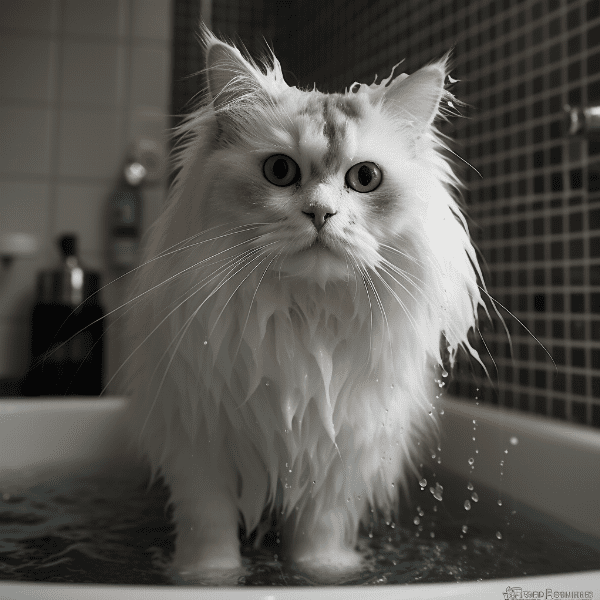
Preparing Your Cat for a Shower
Before you give your cat a bath, it’s important to make sure they are comfortable with the idea and prepared for the experience. Here are some steps you can take to ensure that your cat is ready for their bath:
Gradual Introduction
If your cat has never had a bath before, it’s a good idea to introduce them to the concept gradually. Start by placing your cat in an empty bathtub or sink and giving them treats and positive reinforcement. This will help them associate the bathtub with positive experiences and reduce their stress levels when it comes time for a full bath.
Brushing
Before you give your cat a bath, it’s important to brush them thoroughly to remove any tangles, mats, or loose fur. This will not only make it easier to wash your cat but also reduce the amount of hair that gets into the water and drain.
Trimming Nails
Trimming your cat’s nails before a bath can help prevent scratches and injuries, both for you and your cat. However, it’s important to be gentle and use appropriate tools, as cats can be sensitive about their paws.
Temperature and Water Level
Before you start filling the bathtub or sink with water, make sure the temperature is comfortable for your cat. Lukewarm water is usually the best option, as it’s not too hot or too cold. Additionally, make sure the water level is appropriate for your cat’s size and preferences. Some cats may prefer deeper water while others may prefer shallow water.
Calming Techniques
If your cat is anxious or nervous about the bath, there are several calming techniques you can use to help them relax. Playing calming music, using pheromone sprays or diffusers, or providing treats or toys can all help to reduce your cat’s stress levels and make the bathing experience more positive for them.
By taking these steps to prepare your cat for a bath, you can help to reduce their stress levels and make the experience as comfortable as possible. In the next section, we will discuss how to choose the right shampoo and supplies for your cat’s bath.

Choosing the Right Shampoo and Supplies
Choosing the right shampoo and supplies is essential for a successful and safe cat bath. Here are some factors to consider when selecting your cat’s bath products:
Cat-Specific Products
It’s important to choose shampoo and supplies that are specifically formulated for cats. Human shampoo and other products can be too harsh for a cat’s sensitive skin and can cause irritation, dryness, or other issues. Look for products that are labeled as “cat-specific” or “cat-friendly” to ensure that they are safe for your cat.
Hypoallergenic and Fragrance-Free
Cats can be sensitive to fragrances and other chemicals, so it’s a good idea to choose hypoallergenic and fragrance-free products whenever possible. This will reduce the likelihood of your cat experiencing an allergic reaction or other adverse effects.
Coat Type
Consider your cat’s coat type when choosing shampoo and supplies. If your cat has a long, thick coat, you may need a detangling spray or conditioner to help remove tangles and mats. If your cat has a short coat, a basic shampoo may be sufficient.
Other Supplies
In addition to shampoo, you will also need other supplies for your cat’s bath. This may include a bucket or cup for rinsing, a non-slip mat for the bottom of the tub or sink, and towels for drying. It’s a good idea to have these supplies on hand before you start the bath to make the process as smooth as possible.
Professional Advice
If you’re unsure about which products to use for your cat’s bath or if your cat has specific skin or coat needs, consult with a professional groomer or veterinarian. They can provide recommendations and advice to help ensure that your cat’s bath is safe and effective.
By taking these factors into consideration, you can choose the right shampoo and supplies for your cat’s bath and ensure that the process is as safe and effective as possible. In the next section, we will discuss how to get your cat into the shower or tub.
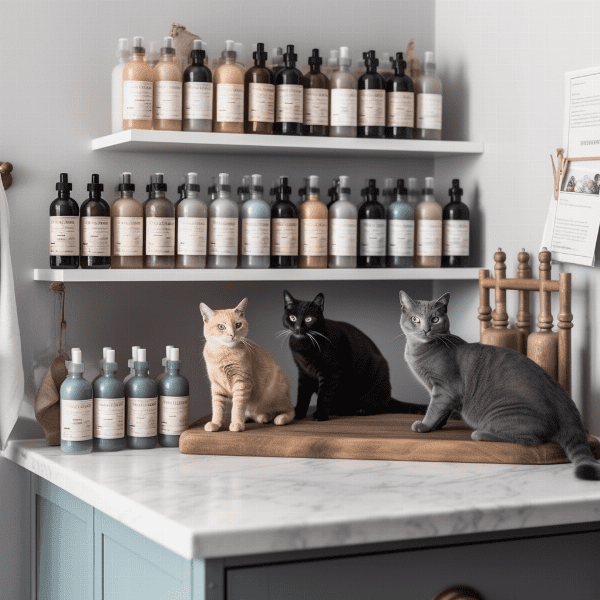
Getting Your Cat into the Shower
Getting your cat into the shower or tub can be one of the most challenging parts of giving them a bath. Here are some tips to make the process as stress-free as possible:
Be Patient
It’s important to approach the process of getting your cat into the shower with patience and calmness. Rushing your cat or becoming frustrated can make the experience stressful for both you and your cat. Take your time and be gentle with your cat throughout the process.
Use Treats and Positive Reinforcement
Using treats and positive reinforcement can help encourage your cat to enter the shower or tub. Place treats or toys in the tub or shower to make it a more positive and enticing experience for your cat.
Lift or Guide Your Cat into the Tub
Depending on your cat’s size and temperament, you may need to lift them or guide them into the tub or shower. Use gentle but firm pressure to guide your cat into the water, and avoid pulling or forcing them.
Provide a Secure and Calm Environment
Make sure the environment in the bathroom is secure and calm before you begin the bath. Close any doors or windows to prevent your cat from escaping or getting distracted, and play calming music or use pheromone sprays to help your cat feel more relaxed.
Use a Cat-Safe Leash or Harness
If your cat is particularly skittish or anxious, you may want to consider using a cat-safe leash or harness to help guide them into the tub. This can provide an extra level of security and prevent your cat from escaping or injuring themselves.
By using these tips, you can help make the process of getting your cat into the shower or tub as stress-free and safe as possible. In the next section, we will discuss how to wash your cat safely and effectively.

Washing Your Cat Safely and Effectively
Washing your cat safely and effectively is crucial to ensure that they stay clean and healthy. Here are some tips for washing your cat:
Wet Your Cat Gradually
Start by wetting your cat gradually, using a cup or bucket to pour water over their body. Be careful not to get water in their eyes, ears, or nose, as this can be uncomfortable or even dangerous for your cat.
Apply Shampoo Gently
Apply shampoo to your cat’s fur using gentle, circular motions. Avoid getting shampoo in your cat’s eyes, ears, or nose, and be careful not to use too much shampoo.
Massage and Scrub
Use your fingers to massage and scrub your cat’s fur, paying particular attention to areas that are particularly dirty or oily. Be gentle but firm, and avoid pulling or tugging on your cat’s fur.
Avoid the Head
Avoid washing your cat’s head and face, as this can be uncomfortable and dangerous for your cat. Instead, use a damp cloth to clean your cat’s face and ears, being careful not to get water or shampoo in their eyes, nose, or ears.
Consider Using a Rinse-Free Shampoo
If your cat is particularly anxious or if you’re concerned about using water, consider using a rinse-free shampoo. These shampoos are formulated to clean your cat’s fur without water and can be a good option for cats that are uncomfortable with baths.
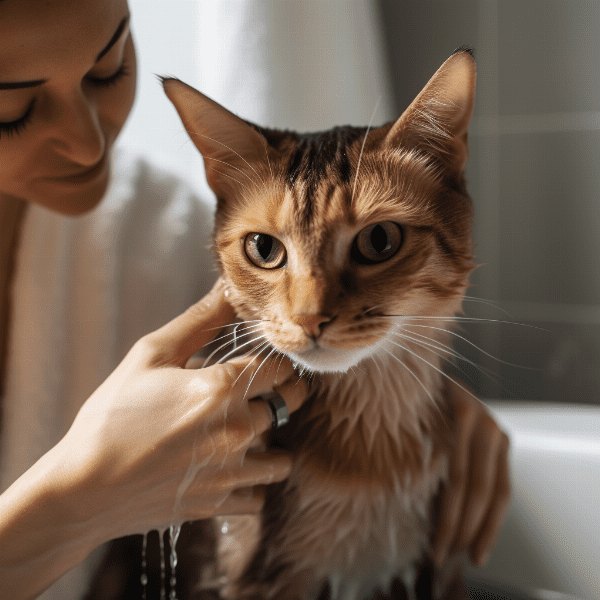
Rinsing and Drying Your Cat
After washing your cat, it’s important to rinse and dry them thoroughly to prevent skin irritation and other issues. Here are some tips for rinsing and drying your cat:
Rinse Thoroughly
Thoroughly rinse your cat’s fur to remove all shampoo residue. Use a cup or bucket to pour water over your cat’s body, and make sure to rinse all areas thoroughly. Be careful not to get water in your cat’s eyes, ears, or nose.
Squeeze Out Excess Water
Gently squeeze out excess water from your cat’s fur using a towel. Be careful not to rub your cat’s fur vigorously, as this can cause irritation and tangling.
Use a Towel to Dry
Use a towel to dry your cat’s fur, gently patting and rubbing to remove excess moisture. Be sure to dry all areas thoroughly, including under their belly and between their toes.
Use a Hairdryer on a Low Heat Setting
If your cat is comfortable with the sound and sensation of a hairdryer, you can use one on a low heat setting to help dry your cat’s fur. Be sure to keep the hairdryer moving to prevent overheating or burning your cat’s skin.
Brush Your Cat’s Fur
After your cat is dry, use a brush to remove any tangles or mats and to help distribute natural oils throughout their coat. This will help to keep your cat’s fur healthy and shiny.
By following these tips, you can help ensure that your cat is thoroughly rinsed and dried after their bath. In the next section, we will discuss how to deal with common challenges that may arise during the bathing process.
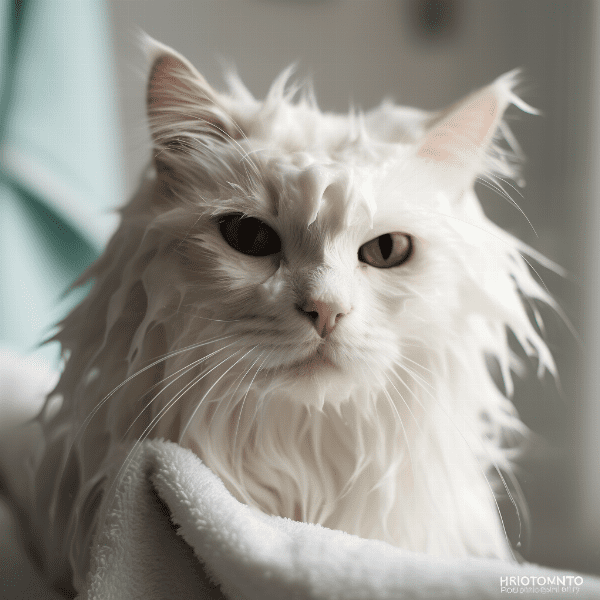
Dealing with Common Challenges
Giving your cat a bath can be a challenging experience, and there are several common issues that may arise. Here are some tips for dealing with common challenges:
Scratching and Biting
Some cats may scratch or bite during a bath, which can be painful and dangerous for you and your cat. If your cat becomes agitated or starts scratching or biting, stop the bath immediately and give them some time to calm down. You may also want to consider using a cat-safe muzzle or seeking the help of a professional groomer.
Fear and Anxiety
Some cats may become fearful or anxious during a bath, which can make the process more challenging. If your cat is particularly anxious, consider using calming techniques such as pheromone sprays, playing calming music, or using treats and positive reinforcement.
Escaping
Some cats may try to escape during a bath, which can be dangerous and stressful for both you and your cat. Make sure the bathroom door is closed and use a non-slip mat in the tub or shower to prevent your cat from slipping and injuring themselves.
Water and Shampoo in Eyes or Ears
Getting water or shampoo in your cat’s eyes or ears can be uncomfortable and dangerous. Be sure to avoid these areas as much as possible, and if your cat does get water or shampoo in their eyes or ears, rinse them thoroughly with clean water.
Drying Difficulties
Drying your cat’s fur thoroughly can be a challenge, particularly if they have a thick or long coat. Consider using a towel or hairdryer on a low heat setting to help dry your cat’s fur, and be sure to brush their fur to prevent tangling and matting.
By being aware of these common challenges and using these tips to address them, you can help ensure that your cat’s bath is safe and effective. In the next section, we will discuss alternatives to full baths for cats.
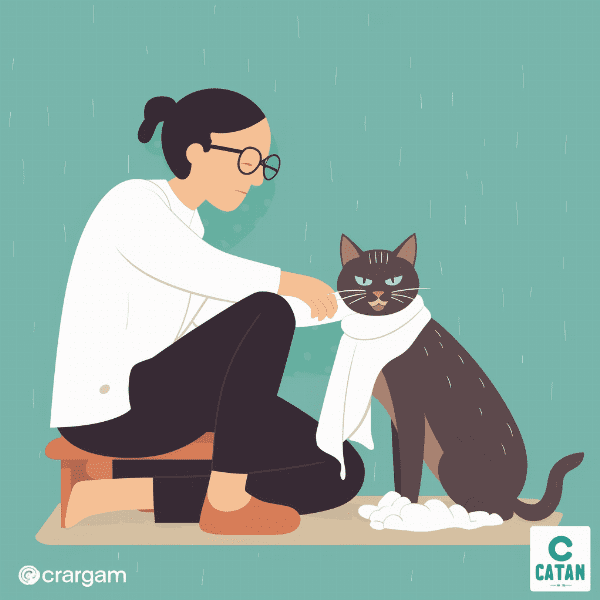
Alternatives to Full Showers for Cats
While baths are a common way to clean cats, they may not be the best option for every cat. Here are some alternatives to full showers for cats:
Dry Shampoo
Dry shampoo is a powder or foam that can be applied to your cat’s fur and rubbed in to clean their coat. This is a good option for cats who are afraid of water or who have sensitive skin.
Waterless Shampoo
Waterless shampoo is a spray or foam that can be applied to your cat’s fur and wiped off with a towel. This is a good option for cats who do not like baths or who are too anxious for a full shower.
Wipes
Cat-specific wipes can be used to clean your cat’s fur and remove dirt and debris. These are a good option for cats who need frequent cleaning but who do not like baths.
Professional Grooming
Professional groomers can provide a range of grooming services, including baths, trims, and haircuts. This is a good option for cats who have particularly challenging grooming needs or who require a more specialized approach.
By considering these alternatives to full showers, you can find a cleaning method that works best for your cat’s needs and preferences. In the next section, we will summarize the key points to remember when showering your cat.
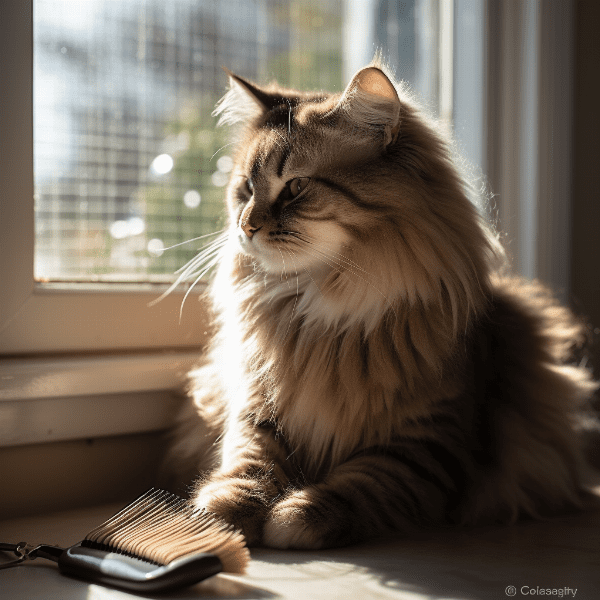
Maintaining Your Cat’s Cleanliness and Health
Keeping your cat clean is an important part of maintaining their overall health and wellbeing. Here are some tips for maintaining your cat’s cleanliness and health:
Regular Brushing
Regular brushing can help prevent matting, tangles, and other issues with your cat’s fur. It can also help distribute natural oils throughout their coat and prevent skin irritation.
Wipe Down
If your cat gets dirty or has an accident, a quick wipe down with a damp cloth or cat-specific wipes can help keep them clean without the need for a full bath.
Regular Checkups
Regular checkups with your veterinarian can help ensure that your cat’s health is in good condition. Your veterinarian can also provide recommendations for your cat’s specific grooming needs.
Healthy Diet
A healthy diet can help keep your cat’s skin and coat in good condition. Be sure to feed your cat a balanced and nutritious diet that is appropriate for their age and activity level.
Regular Nail Trimming
Regular nail trimming can help prevent scratches and damage to your furniture, as well as reduce the risk of infection from overgrown nails.
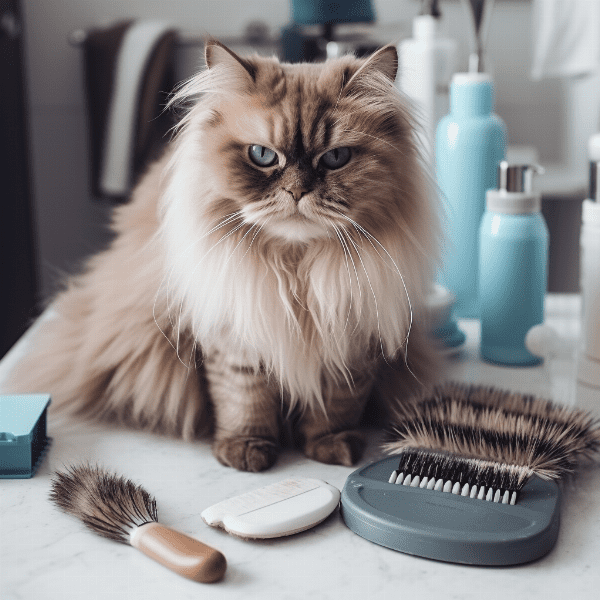
When to Seek Professional Help for Cat Grooming
While many cat owners are able to groom their cats at home, there are some situations where it may be necessary to seek professional help. Here are some instances where you may want to consider taking your cat to a professional groomer:
Severe Matting or Tangles
If your cat’s fur is severely matted or tangled, it may be difficult to remove the mats without causing discomfort or injury to your cat. A professional groomer can help remove mats safely and effectively.
Behavioral Issues
If your cat becomes anxious, fearful, or aggressive during grooming, it may be difficult to safely and effectively groom them at home. A professional groomer can provide a more controlled and safe environment for grooming.
Skin or Coat Issues
If your cat has skin or coat issues such as fleas, ticks, or skin irritation, a professional groomer may be better equipped to handle the issue. They can provide specialized treatments and advice for maintaining your cat’s skin and coat health.
Medical Issues
If your cat has medical issues such as arthritis or mobility issues, grooming may be challenging or uncomfortable for them. A professional groomer can provide specialized care and techniques to accommodate your cat’s specific needs.
By recognizing these situations and seeking professional help when needed, you can help ensure that your cat stays healthy and comfortable. Remember to always approach grooming with patience and care, and seek the help of a professional if needed.
